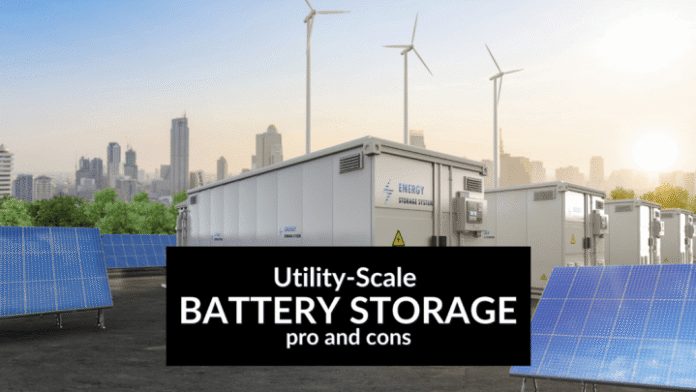Dr. Lars Schernikau: Energy Economist, Commodity Trader, Author (recent book “The Unpopular Truth… about Electricity and the Future of Energy”)
Details inc Blog at www.unpopular-truth.com
As someone who has spent most my professional life in the global energy and commodities space both as an economist and as a trader, I have grown increasingly concerned about the way grid-scale battery storage is portrayed in public discourse. If you have paid any attention to the headlines, you would have heard that battery technology is “on the verge of solving” the intermittency problem of wind and solar energy. According to this narrative, all we need to do is build more battery storage, and the path to “net zero” will unfold automatically… magically.
If only it were that simple…
In my latest blog post “Pros and Cons of Utility-Scale Battery Storage” I unpack the many assumptions behind this belief. The facts I present may be unpopular, but they are grounded in physics, not politics.
Here a couple of key points that I feel might spark some interest.
35 million tons of raw materials for a couple of hours…
To build a 50 GWh utility-scale lithium-ion battery system (approx. annual output of a Gigafactory), which has the ability to store electricity, for a city like New York, for only a few hours, you need ~ 35 million tons of raw materials (~ 700,000 t per GWh). That roughly covers the mining, upgrading, transport, and processing of ores like lithium, cobalt, nickel, graphite, iron ore, bauxite, and others.
Think about it like this…a 1-ton utility-scale battery has a storage capacity of around 100 kWh and requires ~ 70 tons of mined, processed, and manufactured raw materials to be manufactured. This is the energy equivalent of about ~40 kg of coal or ~20 litres of oil.
Let that sink in: 70 tons of mining and industrial processing to store what coal already provides in a (40kg) bag, small enough to be carried by hand.
Explosive potential
These systems are not just material- and energy-intensive, but they also carry serious safety risks. The energy stored in a 1 GWh utility-scale lithium-ion battery system is roughly equivalent to nearly 900 tons of TNT…that is not a metaphor. That is a chemical and thermal reality.
Thermal runaway events have already caused warehouse fires, ship explosions, and data centre shutdowns around the world. And with each battery pack tightly stacked in grid-scale installations, one malfunction can lead to catastrophic chain reactions.
Yet we keep building more?
Power a city for minutes
Let’s do the math.
A 1 GWh utility-scale battery system, requiring ~700,000 tons of mined and processed raw materials, can power:
- all of Berlin for about 30 minutes (assuming 2 GW peak power)
- or all of Germany for just under a minute (at peak power of 80 GW)
To back up Germany’s electricity demand for just 1 hour, we would need around ~80 GWh of battery storage, equating to ~ 56 million tons of raw materials…not to mention the energy-intensive industrial processes just to build them.
Now imagine a week long “Dunkelflaute”…seven days without sun or wind. That would require over 10 TWh of battery storage.
And remember… these batteries deteriorate at a rate of 3-7 % p.a. and must be replaced every ~10-13 years!
No country on Earth, not even with unlimited capital, can seriously consider batteries as a solution. They must know deep down, it is physically and economically unworkable.
Energy to build batteries?
What’s even more startling is the energy invested before these batteries ever store a single kilowatt-hour. Consider, a 1 GWh of utility-scale battery system requires approximately 450 GWh of energy just to be manufactured including the energy required for metals and materials. That’s ~450 times more energy input than its rated storage capacity…a multiplier often ignored in public discussions.
In other words, before a battery can deliver its first useful cycle of electricity, it has already consumed more energy than it will discharge in hundreds of cycles. This raises serious questions about the EROI (Energy Returned on Energy Invested) and the sustainability of making use of these large-scale batteries.
The economics don’t work
I have written extensively about how Levelized Cost of Electricity (LCOE) is a misleading metric. It ignores natural capacity factors, storage and backup costs, and system integration expenses. A more appropriate measure is FCOE (Full Cost of Electricity) which includes all the invisible infrastructure required to make wind, solar, and batteries “work.”
When viewed this way, power systems that required utility-scale batteries have one of the lowest Energy Return on Investment (EROI) ratios in the energy world. It takes a lot of energy to build the system and you get very little usable energy in return.
This is the opposite of what powered human development for the last 150 years.
I want to leave you with the difficult questions …
- Will we be pro- or digressing if we rely on these so-called “green” storage solutions?
- Will the solution of wind, solar and batteries be better for the environment?
You be the judge…
Read my full blog post – Pros and Cons of Utility Scale Battery Storage. I am excited to hear your feedback on this “explosive” topic 😉
Related
Discover more from Watts Up With That?
Subscribe to get the latest posts sent to your email.
